- Home
- Tony Hillerman
A Thief of Time
A Thief of Time Read online
A Thief of Time
Tony Hillerman
This story is dedicated to Steven Lovato,
firstborn son of Larry and Mary Lovato.
May he always go with beauty
all around him.
Contents
Map
Author’s Note
One
THE MOON HAD RISEN just above the cliff behind her.
Two
“ELEANOR FRIEDMAN HYPHEN BERNAL.” Thatcher spaced the words, pronouncing them…
Three
IT HAD BEEN A BAD DAY for Officer Jim Chee…
Four
FULL DARKNESS CAME LATE on this dry autumn Saturday. The…
Five
“REMEMBER, BOY,” Uncle Frank Sam Nakai would sometimes tell Chee,…
Six
LEAPHORN CAME HOME to Window Rock long after midnight. He…
Seven
JIM CHEE SAT on the edge of his bunk, rubbed…
Eight
LEAPHORN HAD BEEN AWARE of the wind most of the…
Nine
THIS IS JUST ABOUT where they’d left the U-Haul truck…
Ten
FROM THE DESPOILED OUTLIER SITE to the eastern boundary of…
Eleven
FOR MOST OF HIS LIFE—since his early teens at least—knowing…
Twelve
IT WAS RAINING IN NEW YORK. L. G. Marcy, the director of…
Thirteen
FINDING THE REVEREND SLICK NAKAI had not been easy. At…
Fourteen
LEAPHORN MANAGED a forward seat by the window when he…
Fifteen
THE YOUNG WOMAN to whom Chee’s call was referred at…
Sixteen
TO LEAPHORN, the saddle had seemed a promising possibility. She…
Seventeen
TRAILERS ARE POOR PLACES to sleep on those nights when…
Eighteen
FINDING THE KAYAK Eleanor Friedman-Bernal had borrowed seemed simple enough…
Nineteen
AS HARRISON HOUK’S MESSAGE to him had promised, Dr. Eleanor Friedman-Bernal…
Acknowledgments
Praise
Other Books by Tony Hillerman
Credits
Copyright
About the Publisher
Map
AUTHOR’S NOTE: While most of the places in this volume are real, Many Ruins Canyon has had its name changed and its location tinkered with to protect its unvandalized cliff ruins.
ONE
THE MOON HAD RISEN just above the cliff behind her. Out on the packed sand of the wash bottom the shadow of the walker made a strange elongated shape. Sometimes it suggested a heron, sometimes one of those stick-figure forms of an Anasazi pictograph. An animated pictograph, its arms moving rhythmically as the moon shadow drifted across the sand. Sometimes, when the goat trail bent and put the walker’s profile against the moon, the shadow became Kokopelli himself. The backpack formed the spirit’s grotesque hump, the walking stick Kokopelli’s crooked flute. Seen from above, the shadow would have made a Navajo believe that the great yei northern clans called Watersprinkler had taken visible form. If an Anasazi had risen from his thousand-year grave in the trash heap under the cliff ruins here, he would have seen the Humpbacked Flute Player, the rowdy god of fertility of his lost people. But the shadow was only the shape of Dr. Eleanor Friedman-Bernal blocking out the light of an October moon.
Dr. Friedman-Bernal rested now, sitting on a convenient rock, removing her backpack, rubbing her shoulders, letting the cold, high desert air evaporate the sweat that had soaked her shirt, reconsidering a long day.
No one could have seen her. Of course, they had seen her driving away from Chaco. The children were up in the gray dawn to catch their school bus. And the children would chat about it to their parents. In that tiny, isolated Park Service society of a dozen adults and two children, everyone knew everything about everybody. There was absolutely no possibility of privacy. But she had done everything right. She had made the rounds of the permanent housing and checked with everyone on the digging team. She was driving into Farmington, she’d said. She’d collected the outgoing mail to be dropped off at the Blanco Trading Post. She had jotted down the list of supplies people needed. She’d told Maxie she had the Chaco fever—needed to get away, see a movie, have a restaurant dinner, smell exhaust fumes, hear a different set of voices, make phone calls back to civilization on a telephone that would actually work. She would spend a night where she could hear the sounds of civilization, something besides the endless Chaco silence. Maxie was sympathetic. If Maxie suspected anything, she suspected Dr. Eleanor Friedman-Bernal was meeting Lehman. That would have been fine with Eleanor Friedman-Bernal.
The handle of the folding shovel she had strapped to her pack was pressing against her back. She stopped, shifted the weight, and adjusted the pack straps. Somewhere in the darkness up the canyon she could hear the odd screeching call of a saw-whet owl, hunting nocturnal rodents. She glanced at her watch: 10:11, changing to 10:12 as she watched. Time enough.
No one had seen her in Bluff. She was sure of that. She had called from Shiprock, just to make doubly sure that no one was using Bo Arnold’s old house out on the highway. No one had answered. The house was dark when she’d arrived, and she’d left it that way, finding the key under the flower box where Bo always left it. She’d done her borrowing carefully, disturbing nothing. When she put it back, Bo would never guess it had been missing. Not that it would matter. Bo was a biologist, scraping out a living as a part-timer with the Bureau of Land Management while he finished his dissertation on desert lichens, or whatever it was he was studying. He hadn’t given a damn about anything else when she’d known him at Madison, and he didn’t now.
She yawned, stretched, reached for her backpack, decided to rest a moment longer. She’d been up about nineteen hours. She had maybe two more to go before she reached the site. Then she’d roll out the sleeping bag and not get out of it until she was rested. No hurry now. She thought about Lehman. Big. Ugly. Smart. Gray. Sexy. Lehman was coming. She’d wine him and dine him and show him what she had. And he would have to be impressed. He’d have to agree she’d proved her case. That wasn’t necessary for publication—his approval. But for some reason, it was necessary to her. And that irrationality made her think of Maxie. Maxie and Elliot.
She smiled, and rubbed her face. It was quiet here, just a few insects making their nocturnal sounds. Windless. The cold air settling into the canyon. She shivered, picked up the backpack, and struggled into it. A coyote was barking somewhere over on Comb Wash far behind her. She could hear another across the wash, very distant, yipping in celebration of the moonlight. She walked rapidly up the packed sand, lifting her legs high to stretch them, not thinking of what she would do tonight. She had thought long enough of that. Perhaps too long. Instead she thought of Maxie and Elliot. Brains, both. But nuts. The Blueblood and the Poorjane. The Man Who Could Do Anything obsessed by the woman who said nothing he did counted. Poor Elliot! He could never win.
A flash of lightning on the eastern horizon—much too distant to hear the thunder and the wrong direction to threaten any rain. A last gasp of summer, she thought. The moon was higher now, its light muting the colors of the canyon into shades of gray. Her thermal underwear and the walking kept her body warm but her hands were like ice. She studied them. No hands for a lady. Nails blunt and broken. The skin tough, scarred, callused. Anthropology skin, they’d called it when she was an undergraduate. The skin of people who are always out under the sun, working in the dirt. It had always bothered her mother, as everything about her bothered her mother. Becoming an anthropologist instead of a doctor, and then not marrying a doctor. Marrying a Puerto Rican ar
chaeologist who was not even Jewish. And then losing him to another woman. “Wear gloves,” her mother had said. “For heaven’s sake, Ellie, you have hands like a dirt farmer.”
And a face like a dirt farmer too, she’d thought.
The canyon was just as she remembered from the summer she had helped map and catalog its sites. A great place for pictographs. Just ahead, just beyond the cottonwoods on the sheer sandstone wall where the canyon bottom bent, was a gallery of them. The baseball gallery, they called it, because of the great shaman figure that someone had thought resembled a cartoon version of an umpire.
The moon lit only part of the wall, and the slanting light made it difficult to see, but she stopped to inspect it. In this light, the tapered, huge-shouldered shape of the mystic Anasazi shaman lost its color and became merely a dark form. Above it a clutter of shapes danced, stick figures, abstractions: the inevitable Kokopelli, his humped shape bent, his flute pointed almost at the ground; a heron flying; a heron standing; the zigzag band of pigment representing a snake. Then she noticed the horse.
It stood well to the left of the great baseball shaman, mostly in moon shadow. A Navajo addition, obviously, since the Anasazi had vanished three hundred years before the Spanish came on their steeds. It was a stylized horse, with a barrel body and straight legs, but without the typical Navajo tendency to build beauty into everything they attempted. The rider seemed to be a Kokopelli—Watersprinkler, the Navajos called him. At least the rider seemed to be blowing a flute. Had this addition been there before? She couldn’t remember. Such Navajo additions weren’t uncommon. But this one puzzled her.
Then she noticed, at each of three feet of the animal, a tiny prone figure. Three. Each with the little circle representing the head separated from the body. Each with one leg cut away.
Sick. And they hadn’t been here four years ago. These she would have remembered.
For the first time Eleanor Friedman-Bernal became aware of the darkness, the silence, her total isolation. She had dropped her backpack while she rested. Now she picked it up, put an arm through the carry strap, changed her mind. She unzipped a side pocket and extracted the pistol. It was a .25 caliber automatic. The salesman had shown her how to load it, how the safety worked, how to hold it. He had told her it was accurate, easy to use, and made in Belgium. He had not told her that it took an unusual ammunition that one always had to hunt for. She had never tried it out in Madison. There never seemed to be a place to shoot it safely. But when she came to New Mexico, the first day when there was enough wind to blow away the sound, she’d driven out into the emptiness on the road toward Crownpoint and practiced with it. She had fired it at rocks, and deadwood, and shadows on the sand, until it felt natural and comfortable and she was hitting things, or getting close enough. When she used up most of the box of cartridges, she found the sporting goods store in Farmington didn’t have them. And neither did the big place in Albuquerque, and finally she had ordered them out of a catalog. Now she had seventeen bullets left in the new box. She had brought six of them with her. A full magazine. The pistol felt cold in her hand, cold and hard and reassuring.
She dropped it into the pocket of her jacket. As she regained the sandy bottom of the wash and walked up it, she was conscious of the heaviness against her hip. The coyotes were closer, two of them somewhere above her, on the mesa beyond the clifftops. Sometimes the night breeze gusted enough to make its sounds in the brush along the bottom, rattling the leaves on the Russian olives and whispering through the fronds of the tamarisks. Usually it was still. Runoff from the summer monsoons had filled pools along the rocky bottom. Most of these were nearly dry now, but she could hear frogs, and crickets, and insects she couldn’t identify. Something made a clicking sound in the darkness where dead tumbleweed had collected against the cliff, and from somewhere ahead she heard what sounded like a whistle. A night bird?
The canyon wound under the cliff and out of the moonlight. She turned on her flash. No risk of anyone seeing it. And that turned her thoughts to how far the nearest human would be. Not far as the bird flies—perhaps fifteen or twenty miles as the crow flew. But no easy way in. No roads across the landscape of almost solid stone, and no reason to build roads. No reason for the Anasazi to come here, for that matter, except to escape something that was hunting them. None that the anthropologists could think of—not even the cultural anthropologists with their notorious talents for forming theories without evidence. But come they had. And with them came her artist. Leaving Chaco Canyon behind her. Coming here to create more of her pots and to die.
From where Dr. Friedman-Bernal was walking she could see one of their ruins low on the cliff wall to her right. Had it been daylight, she remembered, she could have seen two more in the huge amphitheater alcove on the cliff to her left. But now the alcove was black with shadow—looking a little like a great gaping mouth.
She heard squeaking. Bats. She’d noticed a few just after sundown. Here they swarmed, fluttering over places where runoff had filled potholes and potholes had bred insects. They flashed past her face, just over her hair. Watching them, Ellie Friedman-Bernal didn’t watch where she was walking. A rock turned under her foot, and she lost her balance.
The backpack cost her enough of her usual grace to make the fall hard and clumsy. She broke it with her right hand, hip, and elbow and found herself sprawled on the stream bottom, hurt, shocked, and shaken.
The elbow was most painful. It had scraped over the sandstone, tearing her shirt and leaving an abrasion that, when she touched it, stained her finger with blood. Then her bruised hip got her attention, but it was numb now and would punish her later. It was only when she scrambled back to her feet that she noticed the cut across the palm of her hand. She examined it in the light of her flash, made a sympathetic clicking sound, and then sat down to deal with it.
She picked out a bit of the gravel imbedded in the heel of her hand, rinsed the cut from her canteen, and bandaged it with a handkerchief, using left hand and teeth to tighten the knot. And then she continued up the wash, more careful now, leaving the bats behind, following a turn back into the full moonlight and then another into the shadows. Here she climbed onto a low alluvial ledge beside the dry streambed and dumped her pack. It was a familiar place. She and Eduardo Bernal had pitched a tent here five summers ago when they were graduate students, lovers, and part of the site-mapping team. Eddie Bernal. Tough little Ed. Fun while it lasted. But not much fun for long. Soon, surely before Christmas, she would drop the hyphen. Ed would hardly notice. A sigh of relief, perhaps. End of that brief phase when he’d thought one woman would be enough.
She removed a rock, some sticks, smoothed the ground with the edge of her boot sole, dug out and softened an area where her hips would be, and then rolled out the sleeping bag. She chose the place where she had lain with Eddie. Why? Partly defiance, partly sentiment, partly because it was simply the most comfortable spot. Tomorrow would be hard work and the cuts on her palm would make digging difficult and probably painful. But she wasn’t ready for sleep yet. Too much tension. Too much uneasiness.
Standing here beside the sleeping bag, out of the moonlight, more stars were visible. She checked the autumn constellations, found the polestar, got her directions exactly right. Then she stared across the wash into the darkness that hid what she and Eddie had called Chicken Condo. In the narrow stone alcove, Anasazi families had built a two-story dwelling probably big enough for thirty people. Above it, in another alcove so hidden that they wouldn’t have noticed it had Eddie not wondered where an evening bat flight was coming from, the Anasazi had built a little stone fort reachable only by a precarious set of hand-and footholds. It was around the lower dwelling that Eleanor Friedman-Bernal first had found the peculiar potsherds. If her memory didn’t fool her. It was there, when it was light enough tomorrow, that she would dig. In violation of Navajo law, of federal law, and of professional ethics. If her memory only had not fooled her. And now she had more evidence than just her memory.
Her memory had been excellent. It took her unerringly and without a misstep on an easy climb up the talus slope and along the natural pathway to the rim. There she paused and turned her light onto the cliff. The petroglyphs were exactly as she had stored them in her mind. The spiral that might represent the sipapu from which humans had emerged from the womb of Mother Earth, the line of dots that might represent the clan’s migrations, the wide-shouldered forms that the ethnographers believed represented kachina spirits. There, too, cut through the dark desert varnish into the face of the cliff, was the shape Eddie had called Big Chief looking out from behind a red-stained shield, and a figure that seemed to have a man’s body but the feet and head of a heron. It was one of her two favorites, because it seemed so totally unexplainable even by the cultural anthropologists—who could explain anything. The other was another version of Kokopelli.
Wherever you found him—and you found him everywhere these vanished people carved, and painted, their spirits into the cliffs of the Southwest—Kokopelli looked about the same. His humpbacked figure was supported by stick legs. Stick arms held a straight line to his tiny round head, making him seem to be playing a clarinet. The flute might be pointed down, or ahead. Otherwise there was little variation in how he was depicted. Except here. Here Kokopelli was lying on his back, flute pointed skyward. “At last,” Eddie had said. “You have found Kokopelli’s home. This is where he sleeps.”

 People of Darkness
People of Darkness Talking God jlajc-9
Talking God jlajc-9 Skinwalkers jlajc-7
Skinwalkers jlajc-7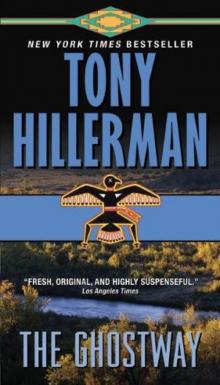 The Ghostway jlajc-6
The Ghostway jlajc-6 The Dark Wind jlajc-5
The Dark Wind jlajc-5 The Blessing Way
The Blessing Way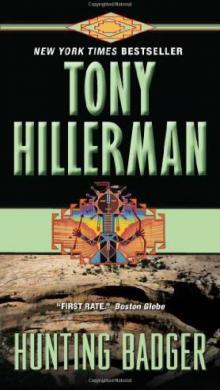 Hunting Badger jlajc-14
Hunting Badger jlajc-14 Seldom Disappointed: A Memoir
Seldom Disappointed: A Memoir Coyote Waits jlajc-10
Coyote Waits jlajc-10 Skeleton Man jlajc-17
Skeleton Man jlajc-17 The Shape Shifter
The Shape Shifter Sacred Clowns jlajc-11
Sacred Clowns jlajc-11 The Fallen Man jlajc-12
The Fallen Man jlajc-12 The First Eagle jlajc-13
The First Eagle jlajc-13 Listening Woman jlajc-3
Listening Woman jlajc-3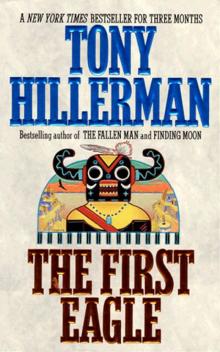 The First Eagle
The First Eagle Skeleton Man
Skeleton Man The Sinister Pig jlajc-16
The Sinister Pig jlajc-16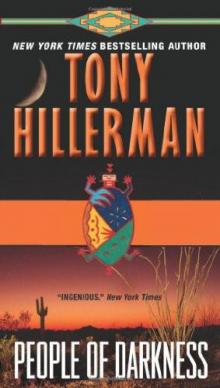 People of Darkness jlajc-4
People of Darkness jlajc-4 The Blessing Way jlajc-1
The Blessing Way jlajc-1 A Thief of Time
A Thief of Time The Wailing Wind
The Wailing Wind A Thief of Time jlajc-8
A Thief of Time jlajc-8 The Wailing Wind jlajc-15
The Wailing Wind jlajc-15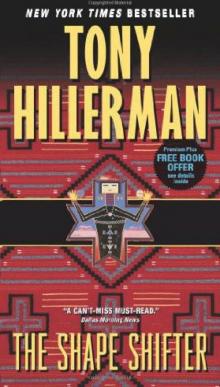 The Shape Shifter jlajc-18
The Shape Shifter jlajc-18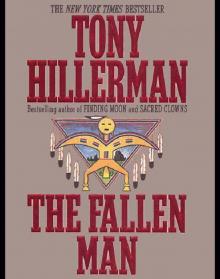 The Fallen Man
The Fallen Man Finding Moon
Finding Moon